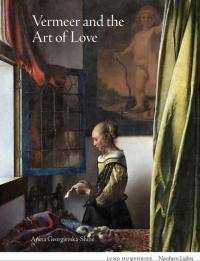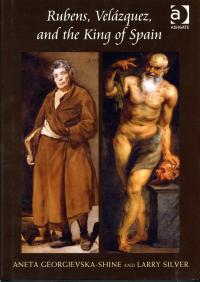Aneta Georgievska-Shine

Senior Lecturer, Renaissance and Baroque Art, Theory; Director of Undergraduate Studies, Art History and Archaeology
Honors Humanities Faculty Fellow, College of Arts and Humanities
agshine@umd.edu
4220 Parren J. Mitchell Art-Sociology Building
Get Directions
Education
Ph.D., , University of Maryland
Research Expertise
Art Theory
Early Modern Studies
Museum Studies
Visual Culture
Aneta Georgievska-Shine, PhD University of Maryland, teaches a variety of courses in early modern art, as well as in theories and methods of research, museum studies, and other special topics of interdisciplinary nature. Her interest in artistic dialogues across different cultures is exemplified by books such as Rubens and the Archaeology of Myth: Visual and Poetic Memory, 2009, and Rubens, Velázquez and the King of Spain, 2014, co-authored with Larry Silver (University of Pennsylvania). Her articles on Northern European, Italian, and Spanish art have appeared in academic journals including the Art Bulletin, Word and Image, Artibus et Historiae, Nederlands Kunsthistorisch Jaarboek, Marburger Jahrbuch für Kunstwissenschaft, Intersections, and the Journal of the Historians of Netherlandish Art. In addition, she has contributed essays to thematic volumes edited by leading scholars, including: The Subject as Aporia in Early Modern Art (2010), Parody and Festivity in Early Modern Art (2012), The Enduring Legacy of Venetian Art (2016), Velázquez Re-Examined: Theory, History, Poetry, and Theater (2017), and Velázquez: El Arte Nuevo (2021).
Beyond her areas of scholarly focus, she has curated a number of exhibitions focusing on modern and contemporary art. In that context, she has written catalogue essays and co-authored books such as Emilie Brzezinski: The Lure of the Forest (2014) and Jiří Kolář: Forms of Visual Poetry (2019).
Her latest book, Vermeer and the Art of Love (2022), explores this theme both as it informs the artist’s work on a personal level and as an expression of his ways of seeing and painting in general.
Publications
Vermeer and the Art of Love
A thoughtful consideration of Vermeer's painted meditation of love
Author/Lead: Aneta Georgiev…
Vermeer and the Art of Love deals with private emotions evoked in domestic interiors in which a young woman may be writing a letter to her absent beloved or playing a virginal in the presence of an admirer. But it is also about the love we sense in the painter’s attentiveness to every detail within those rooms, which lends even the most mundane of objects the quality of something extraordinary. In this engaging book, the author uncovers the ways in which Vermeer challenges the dichotomies between 'good' and 'bad' love, the sensual and the spiritual, placing him within the context of his contemporaries, as well as within the broader discourse on love and art in early modern Europe.
“’Man carries all animals within himself’. Rubens, the satyr, and the song of nature”
An exploration of how Rubens reconciled the human/animal relationship in the figure of the satyr
Author/Lead: Aneta Georgiev…This essay addresses Rubens’s perspective on the human/animal relationship as exemplified by the figure of the satyr. As the author argues, in addition to established associations with ideas of unbridled sensuality, this liminal character relates to deeper philosophical considerations about the interconnectedness of all living beings. Furthermore, a closer look at the connection between the satyr and the literary satire demonstrates that Rubens’s satiric images bear a number of salient qualities of this genre as one that destabilizes all boundaries: be it between the beautiful and the repulsive, the tragic and the comical, or the sublime and the grotesque.
“'A counterfeit of what has to decay': Vermeer and the Mapping of Absence in A Woman with a Lute"
An essay on the power of art to bring the absent into presence, as thematized by a Vermeer painting
Author/Lead: Aneta Georgiev…This essay explores Vermeer’s painting known as A Woman with a Lute as a visual poem on amorous and artistic longing. A closer look at its key elements—from the musical instrument being tuned by the lady to the map on the wall behind her—shows that this seemingly unmediated view into a private world is as engaged with ideas as Vermeer’s more overtly allegorical compositions. Most notable among these ideas are the relationship between the microcosm and the macrocosm, the notion that every record of the present is a form of “history,” and that the art of painting is no less eloquent in its silence than its sister arts of music or poetry. Ultimately, as in many other images of solitary females, the artist pulls us into a circle of desire, effectively turning us from beholders to coparticipants in a “composition” whereby the absent comes back into presence.
Rubens, Velázquez, and the King of Spain
A study of the painted decorations for the hunting lodge of King Philip IV of Spain by two of the greatest old masters – Rubens and Velazquez
Author/Lead: Aneta Georgiev…
This study provides a new analysis of the pictorial ensemble of the Torre de la Parada, the hunting lodge of King Philip IV of Spain. Created in the late 1630s by a group of artists led by Peter Paul Rubens, this cycle was completed by Diego Velázquez. Despite the lack of a written program, surviving works provide eloquent testimony of several themes revolving around Neostoic ideals of self-restraint and prudent governance. Rubens set the moral tone through his serio-comic Ovidian narratives, complemented by Velázquez’s portraits of ancient philosophers, and royals and fools of the court. This study is the first to consider in depth their joint artistic contributions and shared ambition.
Rubens and the Archaeology of Myth (1610-1620): Visual and Poetic Memory
A book that explores the role of visual and poetic memory in Rubens’s interpretations of classical myths.
Author/Lead: Aneta Georgiev…This book focuses on several mythological paintings created by Rubens between 1610 and 1620. Even by the standards of erudition commonly applied to his oeuvre, these works demonstrate a particularly intense engagement on his part with questions of artistic originality and ideal style. Furthermore, their learned themes point to a rarefied audience steeped in classical and renaissance theories. Through these close readings, the author illuminates the importance of the rhetorical conventions of the period for Rubens’s mode of composition, or the intersection of the poetic and the “archaeological” in his approach to themes drawn from classical mythology.
Read More about Rubens and the Archaeology of Myth (1610-1620): Visual and Poetic Memory

